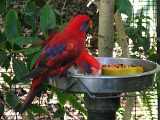
Blue-eared Lory
Encyclopedia
The Blue-eared Lory (also known as Ceram Lory, Half-masked Lory or Seram Lory) is a parrot
found only on the island of Seram
in Maluku province, Indonesia
.
The Blue-eared Lory is the smallest Eos
at 24 cm long. It has a red body with blue cheeks, chin, and ear-coverts, purple-blue abdomen and undertail coverts, and black streaked wings. The adult has an orange beak with juvenile's pink.
The Blue-eared Lory is sometimes found in the altitude as low as 800m, but primarily from 1600-2400m. It feeds on flowering trees, including tree-heathers above the tree-line. The flocks are small.
A common species in its limited range, the Blue-eared Lory is evaluated as Least Concern on the IUCN Red List
of Threatened Species.
Parrot
Parrots, also known as psittacines , are birds of the roughly 372 species in 86 genera that make up the order Psittaciformes, found in most tropical and subtropical regions. The order is subdivided into three families: the Psittacidae , the Cacatuidae and the Strigopidae...
found only on the island of Seram
Seram
Seram is an island in the Maluku province of Indonesia. It is located north of Ambon Island. The chief port/town is Masohi.- Geography and geology :...
in Maluku province, Indonesia
Indonesia
Indonesia , officially the Republic of Indonesia , is a country in Southeast Asia and Oceania. Indonesia is an archipelago comprising approximately 13,000 islands. It has 33 provinces with over 238 million people, and is the world's fourth most populous country. Indonesia is a republic, with an...
.
The Blue-eared Lory is the smallest Eos
Eos (genus)
Eos is a genus of parrots belonging to the Lories and lorikeets. There are six species which are all endemic to islands of eastern Indonesia, most within very restricted ranges. They have predominantly red plumage with blue, purple or black markings. Males and females are similar in...
at 24 cm long. It has a red body with blue cheeks, chin, and ear-coverts, purple-blue abdomen and undertail coverts, and black streaked wings. The adult has an orange beak with juvenile's pink.
The Blue-eared Lory is sometimes found in the altitude as low as 800m, but primarily from 1600-2400m. It feeds on flowering trees, including tree-heathers above the tree-line. The flocks are small.
A common species in its limited range, the Blue-eared Lory is evaluated as Least Concern on the IUCN Red List
IUCN Red List
The IUCN Red List of Threatened Species , founded in 1963, is the world's most comprehensive inventory of the global conservation status of biological species. The International Union for Conservation of Nature is the world's main authority on the conservation status of species...
of Threatened Species.

